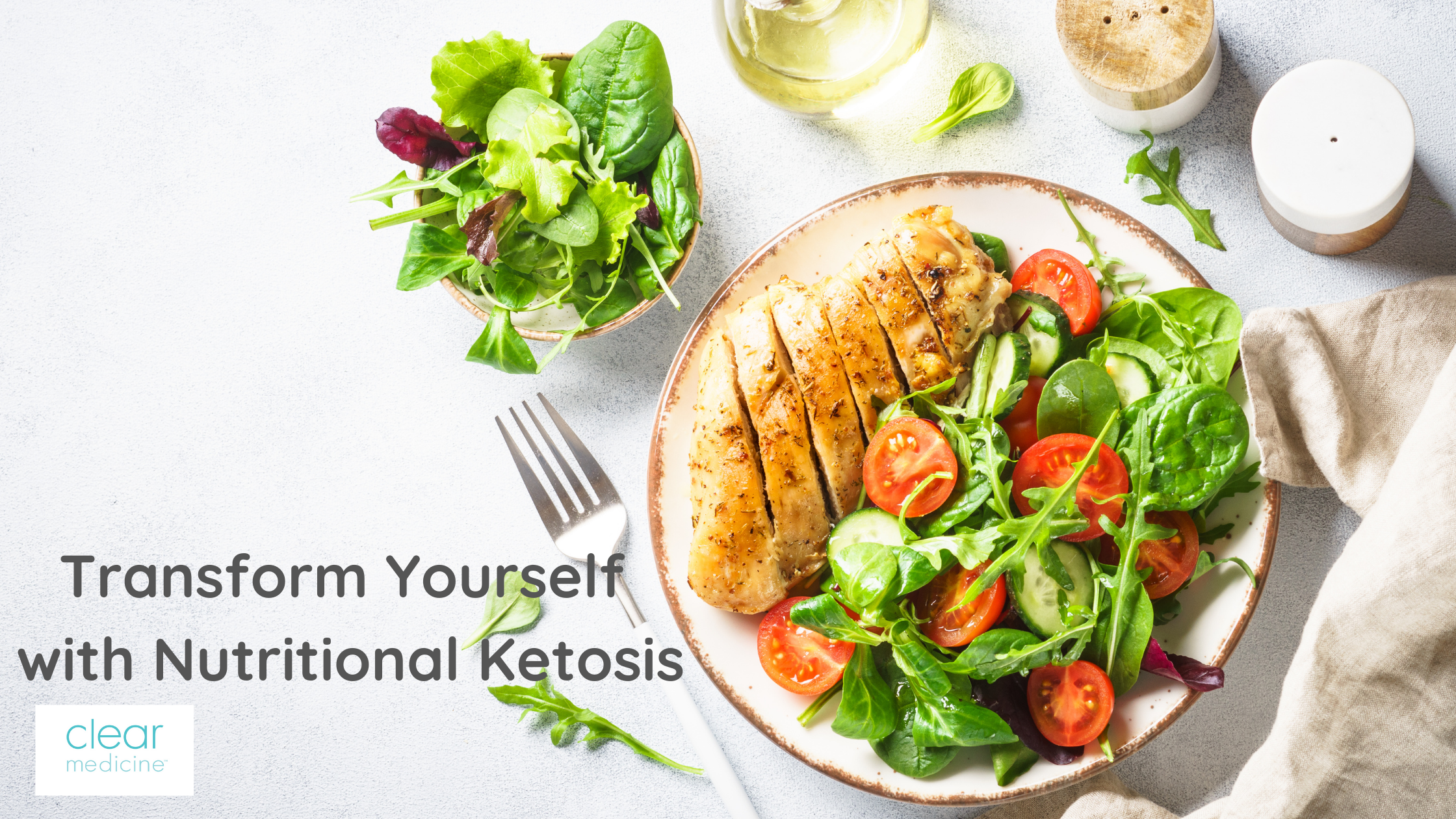Nutritional Ketosis: A Better Way to Fat Loss and Metabolic Reset
Posted by New York Times Bestselling Author of The Supercharged Hormone Diet and The Hormone Diet, Natasha Turner on 24th Sep 2024
It is not necessary to eat a high-fat, moderate-protein, restricted-carb diet (one that includes only green vegetables) to get into ketosis. In fact, we can eat less or move more to get into ketosis—which is simply the state in which your body is burning fat, and you can test your ketones each morning with urinary Ketostix to ensure you are in ketosis.
I suggest getting into ketosis by choosing to consume fewer calories and knowing when you should eat less—for instance, on the days when you are moving less. This can be achieved by reducing starches and eliminating sugars, by reducing fat—the highest-calorie macronutrient—by not eating after 6 or 7 p.m., or even by reducing meals from four to three on days with less activity. You should never eat less than your required amount of protein to maintain your muscle mass.
Nutritional ketosis can be defined as the intentional restriction of dietary carbohydrate intake to accelerate the production of ketones and induce a metabolic effect that stabilizes blood sugar and minimizes insulin release, and thereby mitigates the downstream anabolic and tumorigenic effects of long-standing insulin resistance. This approach represents the best and safest approach and is referred to by some researchers as the “well-formulated” ketogenic diet. It is composed of 5–10 percent carbohydrates (less than 30–50 grams per day mostly in the form of one fruit and plenty of vegetables and starch consumed based on activity), adequate protein (1–1.5 grams per kilogram of body weight per day. My approach, however, recommends 1.6 to 2.2 grams per kilogram of body weight per day for most healthy adults) and fat and starchy carbs based on activity and satiation.
The hallmark of nutritional ketosis is blood ketone levels between 0.5 and 3 milligrams per decilitre. While in nutritional ketosis, the body can maintain normal blood glucose levels and a normal pH, as opposed to the extremely elevated blood sugars and acidic pH associated with diabetic ketoacidosis.
Every metabolism is different. When and how ketosis occurs varies from person to person, which naturally means dietary restrictions, permitted foods and serving sizes need to be adjusted, especially with respect to an individual’s daily activity level. For instance, some people are able to consume one serving of fruit with a low glycemic index in the afternoon and still remain in ketosis, while others do fine if they eat a starchy carb with a low glycemic index, like beets or carrots, on strength-training days.
Let me give you an example to help you modify and implement this suggestion into your daily life: I suggest that, instead of a two-egg meal with avocado, you switch to six egg whites with herbs and veggies (stir-fried or raw in the form of a salad). This change increases protein and decreases fat—helpful especially on days when you are sitting at your desk and you want your body to burn the fat on your body as a fuel source, rather than existing on the fat you take in from your diet.
Here are a couple of days of meals that fit with Nutritional Ketosis dietary approach:
Day 1
Meal 1: one serving of protein powder and one serving of marine collagen with vitamin C (30 grams protein) or even better our longevity kit.
Meal 2: Six egg whites, sheep feta, sautéed zucchini, and peppers with sea salt spice mixture and optional Frank’s RedHot sauce (30 grams protein, two cups/500 milliliters cooked veggies)
Meal 3: Sprague’s cauliflower soup with four ounces (125 grams) of grilled Cajun chicken or one to two spiced chicken kabobs (26–30 grams protein)
Meal 4: Roasted veggies (cauliflower, zucchini, carrots, onions, Brussels sprouts and chopped sweet potato in spices and olive oil) with lemon zest baked sole (30 grams protein, two cups/500 millilitres veggies, one starchy carb)
Day 2
Meal 1: One serving of protein powder and one serving of marine collagen with vitamin C (30 g protein) or even better our longevity kit.
Meal 2: Rainbow Thai Chicken Stir-fry (recipe includes chicken, shredded cabbage, carrots, peppers and zucchini with a tamari-honey-red pepper flake sauce). Weigh out 4½ ounces (135 g) of chicken, which provides about 30 grams of protein.
Meal 3: One kiwi sliced with 1½ cups (375 mL) plain Greek yogurt and 1–2 tablespoons (15–30 mL) of chia seeds (30 g protein)
Meal 4: Carb-Conscious Chicken Taco Lettuce Wraps (made with ground chicken, peppers, zucchini and cauliflower rice, cooked in olive oil and spices, topped with Manchego cheese –measure out four to five ounces of the cooked taco filling to provide approximately 30 grams of protein.
It appears that nutritional ketosis has been studied over the past few years, and it is safe. Just how safe? you may ask. Well, in a study from Current Nutrition Reports (September 2018), nutritional ketosis has been found to improve metabolic and inflammatory markers, including lipids, HbA1c, high-sensitivity C-reactive protein, fasting insulin and glucose levels, and aid in promoting the breakdown of excess fat stores and sparing lean muscle. It also has favourable effects for promoting weight loss, decreasing hunger and increasing satiety. The take-home message is that ketosis is great, but you have to use the new ketosis—nutritional ketosis—to enjoy the best long-term outcome and benefits. And the secret to that is eating enough protein.
Supplement Protocol:
Liver and Fat Metabolism Support
Needed because the liver is your major fat-burning organ. You may want to look for a product that contains lipotropic factors such as burdock root, choline citrate, L-methionine, dandelion root, green tea providing EGCG, magnesium citrate, vitamin B6 as pyridoxal-5-phosphate, iodine and vitamin B12. This blend of botanicals and vitamins are known to increase bile output and support overall liver function. Lipotropic is a term applied to substances that can improve lipid metabolism in the liver and prevent the buildup of fat. It’s important to get a source of choline citrate because deficiency can lead to the accumulation of fat in the liver. Magnesium and vitamin B6 are essential cofactors in a significant number of biochemical reactions, many of which occur in the liver. Search for Clear Lipotrim or a similar product and take two capsules twice a day, with breakfast and dinner or bedtime.
Magnesium
This essential mineral boosts energy, regulates blood sugar levels and supports nervous system health and muscle function. Magnesium is beneficial at bedtime to improve your sleep and mood and to promote healthy bowel activity. It can also help to regulate blood pressure. It’s a very good idea to supplement this mineral, since it’s one of the most common nutrient deficiencies, and more can be lost without a balanced nutritional approach during ketosis. The goal is to take 200–800 milligrams at bedtime. You can achieve this by starting with one pill and increasing by one capsule each night until you reach bowel tolerance (that is, the point at which you begin to have loose stools in the morning). Magnesium glycinate is the most absorbable form.
Calcium
Calcium is one mineral that is involved in the metabolic pathways toward fat burning. We need a decent amount of calcium—not excessive, but not low (around 500–750 milligrams a day from supplements when in ketosis)—in addition to food sources. We tend to lose both chromium and calcium through sweat. Calcium should always be balanced with magnesium—in fact, more magnesium is preferable. Calcium malate, citrate and/or hydroxyapatite are the most advantageous forms.
Potassium
Often, more of this electrolyte is needed because it is lost during the “water loss” phase. Potassium helps to prevent water retention and muscle cramps and spasms. I never travel without it, as it prevents me feeling bloated or puffy. Some sources recommend about 300–600 milligrams twice a day during ketosis. Do not take this without speaking to your pharmacist if you are on a medication for high blood pressure.
Vitamin B Complex with Biotin and Folate
Additional B vitamins are needed for energy, carbohydrate and fat metabolism, mood, energy and stress support. Extra B12 and folate are especially beneficial for brain, bone and heart health, since they support methylation and homocysteine breakdown. And biotin helps with insulin balance, carbohydrate metabolism and healthy skin, hair and nails. Typically one capsule of B complex can be taken at breakfast or lunch.
Other Minerals for Metabolic Support
A multimineral complex or individual supplements can do the trick to supply the minerals you need in higher amounts, including chromium picolinate (400–800 micrograms per day), zinc picolinate (30–50 micrograms per day), iodine and selenomethionine (200 micrograms per day). Note: the amounts in brackets reflect daily totals from all sources—that is, the multivitamin, multimineral or mineral supplements of your choice.

